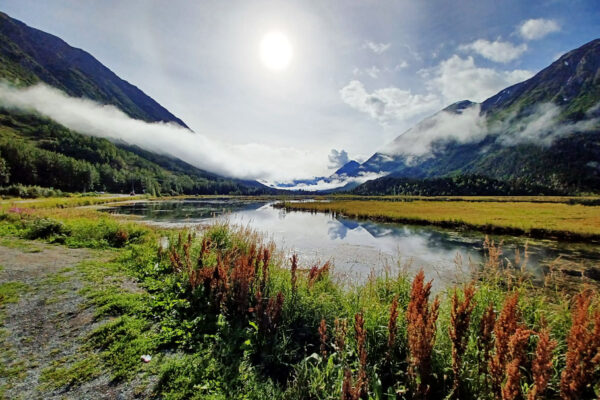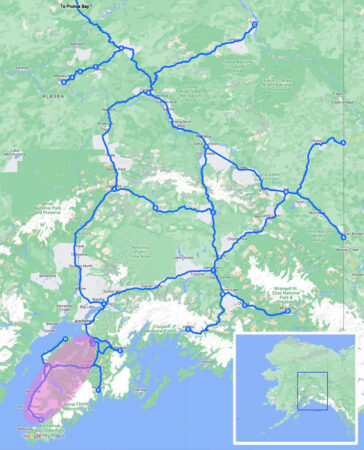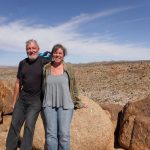
August 1 – 8, 2022
Alaska is a once-in-a-lifetime experience. Opportunities abound to observe wildlife in their natural habitat and witness natural wonders. For a lot of money, there are tours and guides available to help you have a singular adventure or for less money take you along with hundreds of others to incomparable places.
We have a friend who had an amazing time and blew it out in Alaska. He visited every National Park, paid for boat rides and tours, and flightseeing tours. He offered to share some of these experiences, splitting the costs, but honestly, we just didn’t want to spend the money. And besides, I don’t have to see it all. I find that some of the best things we see and do are not only free but are seldom experienced by other people. I love to seek out the off-the-beaten-path adventures, those things that don’t seem as exciting but offer unexpected surprises.
Part 2 of the Kenai Penisula is full of more of these simple things, churches, hikes, visits to museums, a little bit of wildlife, and enlightening day in a library.

Homer Spit
After we left Seward we retraced our path down the Seward Highway until we intersected with the Sterling Highway. We hung a left there and followed the highway all the way to its end on the Homer Spit.
The Homer Spit is a little narrow bar of land that protrudes 4.5 miles out of the bottom of the Kenai Penisula. The highway runs down the middle of the spit and gift shops, restaurants, campgrounds, and other businesses line it on either side. A nice-sized marina with a huge parking lot occupies most of the end of the spit. Overnight parking (but not camping) is allowed for 7 days in the marina parking lot. So we made sure to not camp, kept all of our stuff inside the van, and parked overnight for three days while we explored this end of the Kenai Penisula.
Alaskan Islands & Oceans Visitor Center
We have come to love National Wildlife Refuges. They are like National Parks for people who love to be off the beaten path. Back on the mainland in Homer, we found the Alaskan Islands & Oceans Visitor Center. Here, we learned about the Alaska Maritime National Wildlife Refuge. This refuge “stretches from the spectacular volcanic islands of the Aleutian chain to the Inside Passage, and north to the Chukchi Sea.” It protects sea mammals and over 30 species of birds. And is not accessible by car. Still, the refuge visitor center offers nice displays and ranger talks. We didn’t get to see any Puffins but we learned some interesting things about Sandhill Cranes and how the refuge does research.
Kenai National Wildlife Refuge & Russian River
After we left Homer we headed to another National Wildlife Refuge, the Kenai NWR. This refuge encompasses a large chunk of the Kenai Peninsula. The visitor center had good displays and some very helpful volunteers. There is lots of free camping in the refuge, kayaking trails, hiking trails, and guided ranger talks. We enjoyed a couple of nights of free camping and a hike before we headed on to our next stop, Russian River.
Russian River is located in the Chugach National Forest. Adjacent to the Kenai NWR, Chugach occupies another big chunk of the Kenai Penisula. We had already visited a portion of this National Forest on the first part of our trip to the Kenai Peninsula to see some glaciers. But this area of the forest was a totally different experience. The Russian River flows through here and during the summer, salmon traverse its water swimming upstream in the final journey of their lives. There is a view platform where one can watch these determined fish leaping up the Russian River Falls.
And here is a short video of the salmon jumping.
Russian Churches & Kenai Visitor & Cultural Center
You probably know that before Alaska became a US territory and then a state, it was a Russian colony. Probably the biggest reminder of this is the many Russian Orthodox Churches that dot the state. We visited two of these historical churches and one more modern one on the Kenai Penisula.
We squeezed these trips to the churches in between other things. After we left the van’s lights on all night and had to have our battery jumped the next morning, we decided to give the battery a good charge, leave the Homer Spit for the day, and go for a drive up into the hills to Nikolaevsk. There we found the Church of Saint Nicholas, founded in the 1980s by a group of Orthodox Russian Old Believers who settled in the town around 1968. We visited our second church, Transfiguration of Our Lord Church, in Ninilchik on our way to the Kenai Penisula NWR. And our third, Holy Assumption Russian Orthodox Church, in the town of Kenai was a last-minute change of plans after we decided to not join a ranger led hike on a rainy day.
While we were in Kenai we stopped at the Kenai Visitors & Cultural Center. They had lots of info about the peninsula and a nice museum. I was especially interested in the Russian church relics along with displays about Alaska’s indigenous people.
Hope
Hope, Alaska was our last stop on the peninsula. Friends had told us about this small town (about 150 inhabitants) and had suggested driving Palmer Creek Road which leads out of Hope and into the mountains. Like many of the towns we visited on the peninsula, Hope is one road in and the same road out. We called it an early day on our way there and stopped at a roadside pull-off leading into town. The sky was blanketed with clouds and rain was predicted. We found out that night that the Ballena Blanca’s roof had a leak. When we woke up in the morning it was still raining.
Despite the bad weather we drove on into Hope. The town had a cute little library and we thought we’d do as we often do on rainy days and sit in a library taking advantage of dry space with free internet.
We arrived at the library a little early. The librarian was just getting out of his car. Standing in the rain he told us, “I’d let you in early but I’m a volunteer and I’ve gotten in trouble before for letting people in early.” You wouldn’t think a small town would have such stringent rules – so we got back in the van and drove around. Hope looked interesting but we had no desire to get out and walk around in the rain.
Back at opening time, we joined a few others patrons in the library. Our librarian was chatty and kept a running conversation going, sometimes touching on current affairs and politics. Apparently, he surmised that everyone in the library was on a similar page as him. We had little disagreement with much of what he was saying and no one else voiced different opinions. I’m good at focusing and tuning out conversations but when the new school principal stopped in our librarian was very excited. Everyone in the room learned that this was the first time that Hope’s school principal actually lived in town. Later in the afternoon, a woman came into the library dressed in Viking attire. We learned from her that there was a Viking wedding being held up Palmer Creek Road. And from the librarian, we learned that in just the last year there had also been a Viking funeral in the same location.
We soaked it all in – this small town. Towards the end of the afternoon, we would discover that our volunteer librarian was actually Alaska Quinn and he had been running for president for some time. And would continue to run for some time as he didn’t know how to get his name off the ballot. He has a quite thorough website about his stances.
We closed down the library (as we often do). On our way out Quinn was still talking. We learned a little more about him, got some suggestions about places we should visit next, and advice on how to keep ourselves safe from bears.












































I love the jumping salmon! And what an experience in the library. It’s interesting and entertaining to meet local characters, but, unlike you, I get distracted easily and the constant chatting and chattering in that place would have me annoyed and ready to leave.
I keep wondering if I traveled on the Kenai Peninsula during my multiple-month Alaska journey in 2004. It’s been too long to remember, but most of the towns you mention in these last two posts sound familiar, so I have to think we did explore the peninsula. Also since it’s so easy to reach from the Alaska Highway. I’d have to check my photo albums in Belgium (or ask my ex) to be sure, though.
Yes, the salmon was fun. They are amazing determined fish. There will be more salmon experiences in future blogs.
I found the chatting a little annoying at first. I’m good at tuning out. But then it just became part of the experience. It was fun to learn a little about this small town. And anyways, the weather was awful. Our only option was to go back to Anchorage and sit in the van. I’m glad we stayed.
I bet you probably went to the Kenai Peninsula. It is probably the most accessible part of Alaska. Other places we had really long drives to get to.
I agree with you. When I look back, some of our best and most memorable travel experiences were free and random… just things we stumbled upon and made the most of. It certainly seems like you did the same here. Your last roadside photo is particularly beautiful!
I checked out the website for your librarian/presidential candidate and had 2 thoughts: 1) “Oh yeah… now I remember what websites looked like in 1997…” and 2) “I kinda agree with this guy!”
Crazy times, crazy times.
Sorry, I missed your comment somehow! Too much traveling lately.
Yes, Alaska Quinn’s website is very dated! But at least it’s kind of fun looking. I agree with him too but I think he is a naive if he thinks people will go for all that peace and love stuff! Oh well….
Free and Random should be a motto!